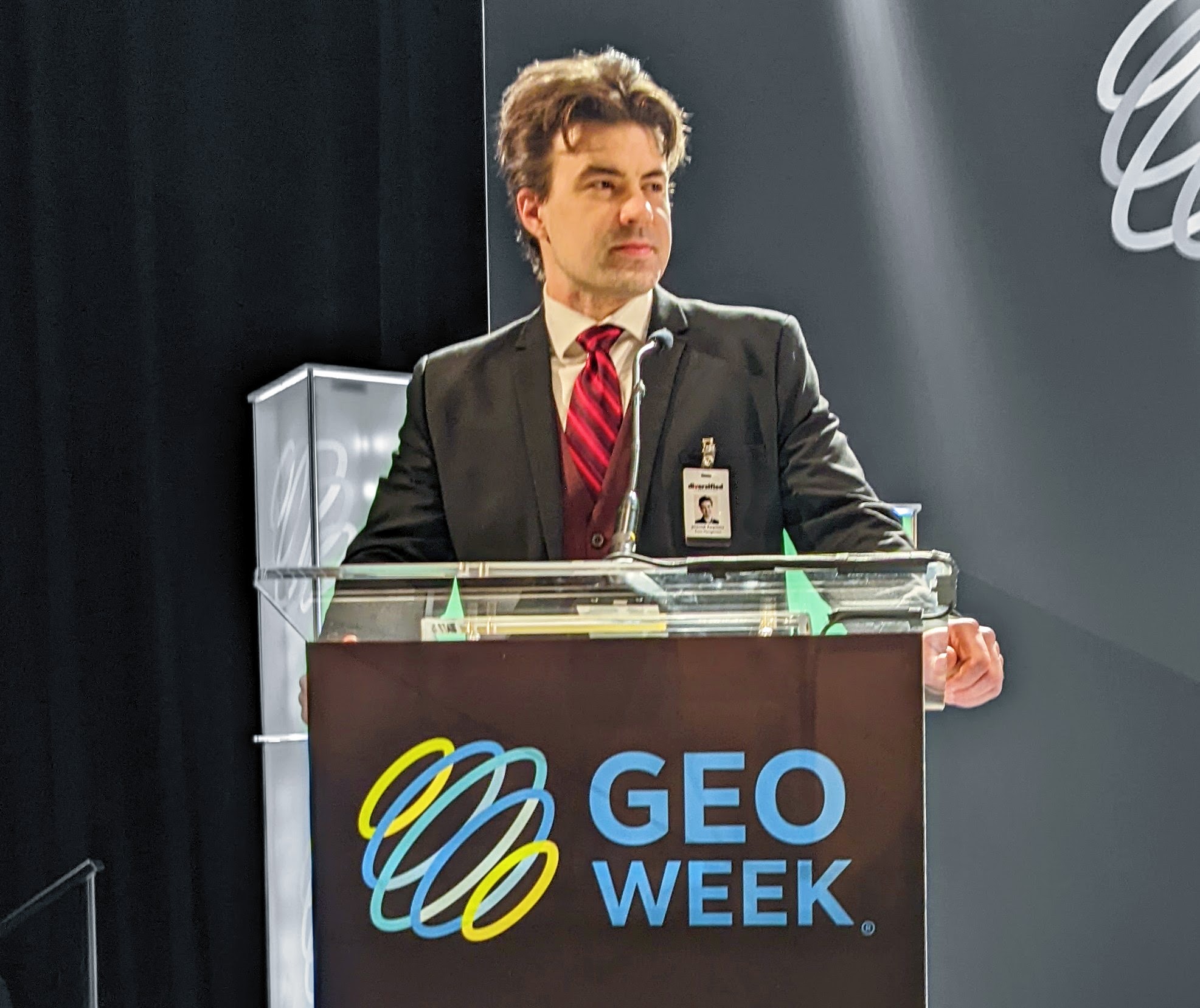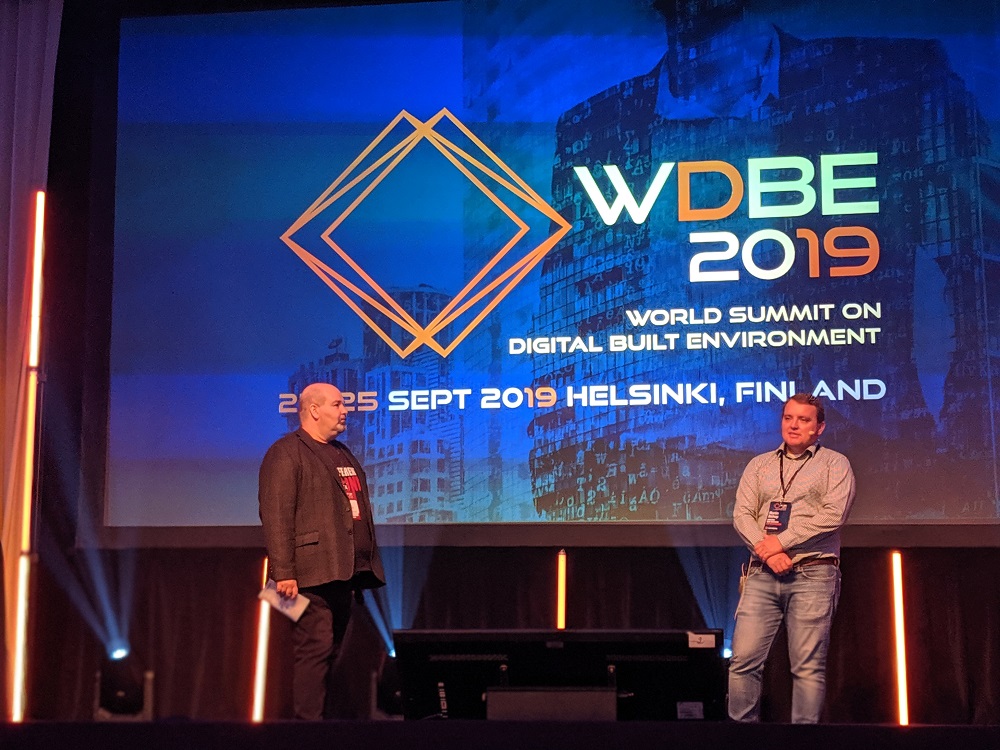The World Summit on Digital Built Environments featured speakers from across the world who are focused on improving the built environment in various ways. How citizens, private companies and public entities can come together to enable new approaches for ecology, mobility, communication and more were major themes at the event, and these issues were explored in a variety of ways across the two-day event.
Digital user services, the more efficient use of BIM, digital twins, city planning, the digital lifecycle, sustainable cites and many other issues were the focus of several tracks and workshops, but these topics came into focus in a big way during the keynote presentations. These keynote presentations provided attendees with a sense of not only what it can mean for them to make their own processes and workflows more efficient, but also how they can be part of a much bigger effort to improve the entire built environment.
“The idea with the e-construction platform we’re building is that it will be compatible with that many more platforms,” from @jaan_saar at #WDBE2019 pic.twitter.com/AgxjA9F9eX
— Jeremiah Karpowicz (@jeremiahkarp) September 24, 2019
Jaan Saar, Head of Digital Construction at the Ministry of Economic Affairs and Communications opened the event with a presentation that was focused on how the construction industry can become defragmented with the support of digital platforms. By its very nature, the construction industry is fragmented with different departments, stakeholders and people focused on various tasks. The “e-construction platform” that Saar is developing is designed to provide the digital infrastructure for collaborative data sharing and the integration of innovative services. The adoption and integration of this system with ones that AEC professionals are already using could open up a new paradigm around the planning, design, construction, and maintenance of built assets.
The great equalizer of the urban condition is spaces that are open and allow the public to freely interact with them as they like, from Eric Buczuk at #WDBE2019 pic.twitter.com/QhGRRECkum
— Jeremiah Karpowicz (@jeremiahkarp) September 24, 2019
Eric Baczuk is the User Experience Lead at Google / Sidewalk Labs and he describes his work as something that exists between urbanism, architecture and technology. His presentation was titled “Gardeners in the City of the Future”, and he highlighted exactly what it will mean to become these urban gardeners. By asking the question, “A user-friendly city is_____” Baczuk was able to explain why cities of the future need to be walkable, dynamic, ambient, mindful and more. He gave specific examples of what these elements can look like, which ranged from spaces that can be adjusted to serve multiple needs throughout the day to the creation of digital detox areas to encourage communities to connect with one another.
What is the impact of smart data? It’s borderline all-encompassing, but needs to go beyond a single segment. From Toni Luhti of @PlatformOfTrust at #WDBE2019 pic.twitter.com/B5c8KNTgns
— Jeremiah Karpowicz (@jeremiahkarp) September 24, 2019
Toni Luhti, CEO of Platform of Trust, explained not only why it’s time that we start using the data we’ve been collecting, but also talked through the ramifications of not doing so. He highlighted all the ways in which data is being siloed by companies that have it stored in multiple solutions, over many locations, and in countless formats. Ultimately, the built environment is a massive source of data, and that data needs to be used to justify and validate decisions across the entire construction ecosystem. That will allow people to ask and answer the right questions.
Luhti’s presentation can be summed up in two key lines: make your processes as automated as possible, and make the data work for you.
What does the culture of innovation at Amazon look like? Martin Bishop explains at #WDBE2019 @WDBESummit pic.twitter.com/jgzXiJniPH
— Jeremiah Karpowicz (@jeremiahkarp) September 25, 2019
Martin Bishop is TechBD Manager EMEA at Amazon Web Services, and he highlighted what it means to drive successful digital transformation in the public sector. He talked about the importance of getting people out of a “caretaking” mode that has them spending time and money on maintaining the status quo as opposed to making needed innovations. While it’s easy to say that an organization wants to focus on their customer, Bishop highlighted how Amazon takes that to a different level by doing things like figuring out who their customer is down to an individual and defining what the customer experience is like. That focus has allowed them to create products that can be opened and made available to people beyond a specific customer or user, which is a lesson that’s especially relevant in the construction industry.
One of the most important things he mentioned was about the approach that’s necessary for effective long-term thinking, which can be flexible on details, but firm on the vision.
Exploring what it means to empower people with inclusive environments, which are a combination of the physical and digital, with Salla Palos from @Microsoft at #WDBE2019 @WDBESummit pic.twitter.com/3ivSBbfSQI
— Jeremiah Karpowicz (@jeremiahkarp) September 25, 2019
What it means to empower people with inclusive environments was the focus of the presentation from Salla Palos, Director of Transformation Services at Microsoft. She mentioned that Microsoft is dedicated to retaining and attracting the best workforce, and it’s something they’re trying to achieve by creating environments that are connected, sustainable, accessible and secure. These environments are a combination of the physical and digital and are ultimately all about answering one question: how can we empower people to achieve more?
“We’re often more focused on creating solutions than identifying the problems, and there are a lot of problems to work through,” from Lu Ying at the #WDBE2019 keynote @WDBESummit pic.twitter.com/9Q4yvScaCm
— Jeremiah Karpowicz (@jeremiahkarp) September 25, 2019
Lu Ying is the Co-founder & Chief Executive Officer at Future Urban Living. The urban innovation pockets that were the focus of her talk are essentially test beds for cities to rethink and redefine built ecosystems, and she mentioned how necessary they are given the waste that is inherent in the construction process. Traditional models are no longer economically or financially viable, which has spurred the creation of these urban innovation pockets that will help define future ecosystems that can be that much more agile and efficient.
BIM is really isn’t about technology, but understanding who needs the info and how it gets passed on. More psychology than technology, from @randydeutsch at #WDBE2019 @WDBESummit pic.twitter.com/1rL25txTeS
— Jeremiah Karpowicz (@jeremiahkarp) September 25, 2019
Randy Deutsch is an architect, author, educator and speaker, and all of these skills were on display during his dynamic presentation. He was focused on what to expect in the next year and beyond, all of which was centered on how design is being redefined and the way in which data should be utilized. He stressed that the technology is not the most important thing, but that someone’s attitude and fit are much more of a priority. Technology can be picked up along the way, and there are many great tools out there. Figuring what to use and when is something that superusers can help define, and those superusers deliver value, regardless of the details. Organizations need to always be on the lookout for superusers.
Shajay Bhooshan explains the distinctions between desirable cities and ones that suffer from urban sprawl at #WDBE2019 @WDBESummit pic.twitter.com/jiokuHlqZi
— Jeremiah Karpowicz (@jeremiahkarp) September 25, 2019
Shajay Bhooshan is from Zaha Hadid Architects in the UK, and his presentation centered on the interplay between the home, communities and games. He discussed his company’s efforts to optimize buildings for user experience and production and showed off several examples of what it looks like when this optimization takes places…and when it doesn’t.
Which sectors are using digital twins? All of the big ones, from Christina Savian at @WDBESummit #WDBE2019 pic.twitter.com/uUrPABzYCr
— Jeremiah Karpowicz (@jeremiahkarp) September 25, 2019
Digital twins were a major topic of discussion throughout the event, but Cristina Savian, Managing Director at BE-WISE, gave the audience a whole new perspective on the topic. She talked about how digital twins should be thought of as a launchpad to inform the user experience of today’s and tomorrow’s generations. She mentioned just a few of the benefits they enable are associated with better prediction behavior, reducing operating costs and better production control.
Minna Perahuhta from the Ministry of the Environment in Finland closes out the #WDBE2019 keynotes with a message about what happens when agility and openness come together with public sector initiatives @WDBESummit pic.twitter.com/MX7Zs7455U
— Jeremiah Karpowicz (@jeremiahkarp) September 25, 2019
Minna Perähuhta from the Ministry of the Environment talked about the importance of open, fair and agile public-private partnerships. She mentioned that these types of relationships are essential to moving the built environment forward but recognized that there are inherent challenges when it comes to establishing these environments. What can everyone share across the built environment? What can they contribute? These are the types of questions that need to be asked, as the built environment is the context in which we live, so the willingness to share and contribute has to take priority.
The perspectives of each World Summit on Digital Built Environments keynote were varied and detailed, allowing the audience to get a real sense of how they can transform their processes and organizations in the present to enable that much more powerful opportunities in the future.






